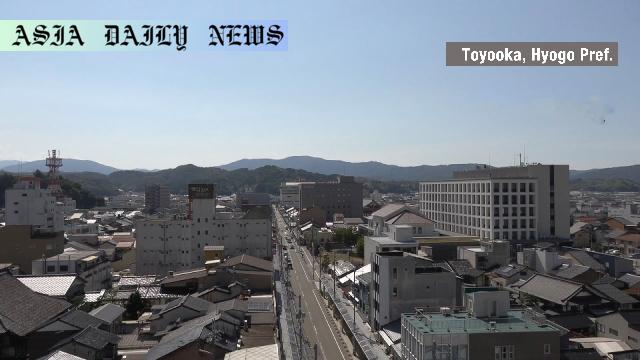Heatwave grips Japan as Hyogo records 41.2°C, the nation’s highest temperature ever observed, prompting urgent health alerts.
Japan records its highest-ever temperature of 41.2°C in Hyogo Prefecture.
Heatwave alerts issued for 33 out of 47 prefectures across Japan.
Meteorological Agency attributes the rise to a high-pressure system.
Authorities advise staying cool, hydrating frequently, and monitoring heatstroke symptoms.

Record-Breaking Heatwave Hits Japan
Japan has recorded its highest temperature ever, with the western region of Hyogo Prefecture witnessing an unprecedented 41.2 degrees Celsius on Wednesday. This record-breaking event surpassed previous highs of 41.1 degrees observed in Kumagaya City, Saitama Prefecture, in 2018 and Hamamatsu City, Shizuoka Prefecture, in 2020. The Japan Meteorological Agency attributes this extreme heat to a high-pressure system which has pushed temperatures to dangerous levels across the nation. In addition to Hyogo, temperatures soared to 40.6 degrees Celsius in Fukuchiyama City, Kyoto Prefecture, and reached 40.0 degrees in Nishiwaki City, also in Hyogo. Such extreme conditions have prompted nationwide heatstroke alerts and a call for increased safety precautions.
Heatwave’s Nationwide Impact
The impact of this heatwave is neither localized nor limited to record-breaking statistics. More than 33 of Japan’s 47 prefectures have issued heatstroke warnings, urging individuals to remain vigilant about their health and safety. Officials have emphasized the importance of taking preventive measures like staying indoors during peak heat hours, maintaining hydration with water and electrolytes, and ensuring regular intervals of rest, especially for those who work or venture outdoors. Such alerts are particularly crucial for vulnerable populations, such as the elderly, children, and individuals with pre-existing health conditions.
Historical Context of Extreme Weather in Japan
Japan has not been unfamiliar with extreme weather conditions, but the recurrence and intensification of heatwaves are concerning. Over recent years, there has been a noticeable uptick in the frequency of high-temperature days exceeding 35 degrees Celsius, colloquially known as “mousho-bi” or “extremely hot days.” The new record of 41.2 degrees places further urgency on understanding and addressing the changing climate patterns in the region. The nation’s continued exposure to such events serves as a stark reminder of the tangible impact of climate change, urging policymakers and citizens to prioritize environmental sustainability efforts.
Immediate Safety Tips and Long-Term Considerations
As the nation grapples with the heatwave, immediate safety measures remain a top priority. Officials recommend staying in air-conditioned spaces, avoiding strenuous outdoor activities during high-temperature hours, and wearing lightweight, breathable clothing. Additionally, people are encouraged to pay close attention to symptoms of heatstroke, such as dizziness, nausea, or fatigue, and to seek medical assistance without delay if such symptoms arise. On a larger scale, this event underscores the need for better infrastructure and urban planning to mitigate the effects of extreme heat. Sustainable architecture, heat-resistant building materials, and ample green spaces could contribute to combating rising temperatures in urban settings.



Commentary
The Growing Challenge of Heatwaves
The record-breaking temperature of 41.2 degrees Celsius in Hyogo marks a grim milestone for Japan—a country that already faces a myriad of natural challenges, from earthquakes to typhoons. The sheer impact of this heatwave, both in physical discomfort and on public health, is a strong reminder of how vulnerable we are to the increasing extremes of weather exacerbated by climate change. This event not only challenges Japan’s infrastructure but also tests its resilience in addressing the evolving needs of its population in such trying circumstances.
Reflecting on Climate Action
As these extreme conditions become more prevalent, it reinforces the pressing need for both local and global climate action. Japan, as a technologically advanced nation, is uniquely poised to lead the charge in developing innovative solutions for adapting to and mitigating the effects of climate change. From renewable energy transitions to improved climate-resilient infrastructure, these measures will not only strengthen Japan’s position in fighting climate change but also serve as a model for other nations.
A Time for Collective Efforts
While government policies and technological advancements hold significant importance, individuals also play an essential role in combating the consequences of climate-related challenges. Simple daily habits, such as conserving electricity, reducing waste, and promoting green spaces in urban areas, can collectively make a substantial impact. Furthermore, moments like these highlight the importance of fostering community spirit—helping vulnerable neighbors, sharing resources, and educating others about safety measures that can save lives.
The record-breaking heatwave in Japan is a wake-up call for all of us. It urges immediate attention to our changing environment and a united effort to ensure that extreme weather does not become the new normal. Together, we can strive towards a sustainable and resilient future.